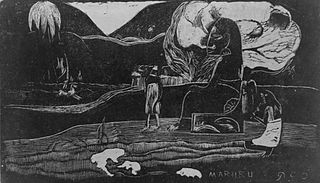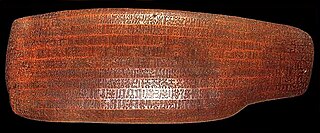Related Research Articles

The Polynesian narrative or Polynesian mythology encompasses the oral traditions of the people of Polynesia together with those of the scattered cultures known as the Polynesian outliers. Polynesians speak languages that descend from a language reconstructed as Proto-Polynesian - probably spoken in the Tonga - Samoa area around 1000 BC.
Māui (Maui) is the great culture hero and trickster in Polynesian mythology. Very rarely was Māui actually worshipped, being less of a deity and more of a folk hero. His origins vary from culture to culture, but many of his main exploits remain relatively similar.

Hina is the name assigned to a number of Polynesian deities. The name Hina usually relates to a powerful female force who has dominion over a specific entity. Some variations of the name Hina include Sina, Hanaiakamalama, and Ina. Even within a single culture, Hina could refer to multiple goddesses and the distinction between the different identities are not always clear. In Hawaiian mythology, the name is usually paired with words which explain or identify the goddess and her power such as Hina-puku-iʻa (Hina-gathering-seafood) the goddess of fishermen, and Hina-ʻopu-hala-koʻa who gave birth to all reef life.
In Hawaiian mythology, Kalamainu'u was a lizard goddess.

Hula is a Polynesian dance form accompanied by chant (Oli) or song. It was developed in the Hawaiian Islands by the Polynesians who originally settled there. The hula dramatizes or portrays the words of the oli or mele in a visual dance form.

A marae, malaʻe, meʻae or malae is a communal or sacred place that serves religious and social purposes in Polynesian societies. In all these languages, the term also means cleared, free of weeds, trees. Marae generally consist of an area of cleared land roughly rectangular, bordered with stones or wooden posts perhaps with paepae (terraces) which were traditionally used for ceremonial purposes; and in some cases, a central stone ahu or a'u. In the Rapa Nui culture of Easter Island, the term ahu has become a synonym for the whole marae complex.
In Māori tradition, Ngātoro-i-rangi (Ngātoro) is the name of a tohunga (priest) prominent during the settling of Aotearoa by the Māori people, who came from the traditional homeland Hawaiki.
In Māori mythology, as in other Polynesian traditions, Māui is a culture hero and a trickster, famous for his exploits and cleverness. He possessed superhuman strength, and was capable of shapeshifting into animals such as birds and worms.

In Hawaiian religion, Māui is a culture hero and ancient chief who appears in several different genealogies. In the Kumulipo, he is the son of ʻAkalana and his wife Hina-a-ke-ahi (Hina). This couple has four sons, Māui-mua, Māui-waena, Māui-kiʻikiʻi, and Māui-a-kalana. Māui-a-kalana's wife is named Hinakealohaila, and his son is named Nanamaoa. Māui is one of the Kupua. His name is the same as that of the Hawaiian island Maui, although native tradition holds that it is not named for him directly, but instead named after the son of Hawaii's discoverer.
Hotu Matuꞌa was the legendary first settler and ariki mau of Easter Island and ancestor of the Rapa Nui people. Hotu Matuꞌa and his two canoe colonising party were Polynesians from the now unknown land of Hiva. They landed at Anakena beach and his people spread out across the island, sub-divided it between clans claiming descent from his sons, and lived for more than a thousand years in their isolated island home at the southeastern tip of the Polynesian Triangle.

Easter Island was traditionally ruled by a monarchy, with a king as its leader.

The Tahai Ceremonial Complex is an archaeological site on Rapa Nui in Chilean Polynesia. Restored in 1974 by the late Dr. William Mulloy, an American archaeologist, Tahai comprises three principal ahu from north to south: Ko Te Riku, Tahai, and Vai Ure. Visible in the distance from Tahai are two restored ahu at Hanga Kio'e, projects that Mulloy undertook in 1972. Like other Mulloy restoration projects at Ahu Akivi, the ceremonial village of Orongo and Vinapu, the ceremonial center at Tahai now constitutes an integral part of the Rapa Nui National Park, designated by UNESCO as a World Heritage site.
The Rapa Nui calendar was the indigenous lunisolar calendar of Easter Island. It is now obsolete.

Text R of the rongorongo corpus, the smaller of two tablets in Washington and therefore also known as the Small Washington tablet, is one of two dozen surviving rongorongo texts.

Text S of the rongorongo corpus, the larger of two tablets in Washington and therefore also known as the Great or Large Washington tablet, is one of two dozen surviving rongorongo texts.

There have been numerous attempts to decipher the rongorongo script of Easter Island since its discovery in the late nineteenth century. As with most undeciphered scripts, many of the proposals have been fanciful. Apart from a portion of one tablet which has been shown to deal with a lunar calendar, none of the texts are understood, and even the calendar cannot actually be read. It is not known if rongorongo directly represents the Rapa Nui language – that is, if it is a true writing system – and oral accounts report that experts in one category of tablet were unable to read other tablets, suggesting either that rongorongo is not a unified system, or that it is proto-writing that requires the reader to already know the text. There are three serious obstacles to decipherment, assuming that rongorongo is writing: the small number of remaining texts, comprising only 15,000 legible glyphs; the lack of context in which to interpret the texts, such as illustrations or parallel texts which can be read; and the fact that the modern Rapa Nui language is heavily mixed with Tahitian and is unlikely to closely reflect the language of the tablets—especially if they record a specialized register such as incantations—while the few remaining examples of the old language are heavily restricted in genre and may not correspond well to the tablets either.

In Hawaiian mythology, Kū or Kūkaʻilimoku is one of the four great gods. The other three are Kanaloa, Kāne, and Lono. Feathered god images or ʻaumakua hulu manu are considered to represent Kū. Kū is worshiped under many names, including Kū-ka-ili-moku, the "Snatcher of Land". Rituals for Kūkaʻilimoku included human sacrifice, which was not part of the worship of other gods.

Irina Konstantinovna Feodorova was a Soviet historian. Her field of expertise was the ethnography, culture, folklore and language of the people of East Polynesia. Feodorova was doctor of historical sciences and a leading scientist of the Department of Australia, Oceania and Indonesia at the Museum of Anthropology and Ethnography at the Kunstkamera, St. Petersberg, the first Russian museum that was named after Peter the Great. In 1981, Feodorova was given the honour of being named N. N. Miklouho-Maclay Laureate of the Presidium of the Russian Academy of Science.

Hotu-iti is an area of southeastern Easter Island that takes its name from a local clan. Located in Rapa Nui National Park, the area includes Rano Raraku crater, the Ahu Tongariki site, and a small bay. In the 15th and 16th centuries, the Hotu-iti clan was one of two polities on Easter Island.
Hineuki was a Hawaiian noble lady and Chiefess of the island of Hawaiʻi as the wife of Kukohou, Aliʻi Nui of Hawaiʻi. She was named after the goddess Hina, who was one of the most important deities in the religion of the Ancient Hawaiians.
References
- ↑ Craig, Robert D. (1989). Dictionary of Polynesian Mythology. Greenwood Publishing Group. p. 351. ISBN 978-0-31325890-9.
- ↑ Métraux, Alfred (1940). Ethnology of Easter Island. Honolulu, Hawaii: Bernice P. Bishop Museum. p. 321.
- ↑ Thomson, William (1891). Te Pito te Henua; or, Easter Island. Smithsonian Institution. pp. 514-522. Archived from the original on 2016-04-04. Retrieved 2018-04-22.
